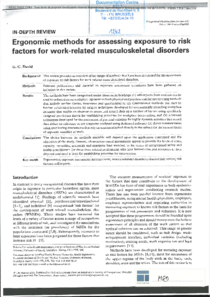Ergonomic methods for assessing exposure to risk factors for work-related musculoskeletal disorders

2005
55
3
190-199
ergonomics ; exposure assessment ; musculoskeletal diseases ; occupational risks
Ergonomics and work environment
English
Bibliogr.;Charts
"Background: This review provides an overview of the range of methods that have been developed for the assessment of exposure to risk factors for work-related musculoskeletal disorders. Methods: Relevant publications and material on exposure assessment techniques have been gathered for inclusion in this review. Results: The methods have been categorized under three main headings: (1) self-reports from workers can be used to collect data on workplace exposure to both physical and psychosocial factors by using methods that include worker diaries, interviews and questionnaires; (2) observational methods that may be further subdivided between (a) simpler techniques developed for systematically recording workplace exposure that enable an observer to assess and record data on a number of factors using specifically designed pro-forma sheets for establishing priorities for workplace intervention; and (b) advanced techniques developed for the assessment of postural variation for highly dynamic activities that record data either on videotape or are computer analysed using dedicated software; (3) direct measurements using monitoring instruments that rely on sensors attached directly to the subject for the measurement of exposure variables at work. Conclusions: The choice between the methods available will depend upon the application concerned and the objectives of the study. General, observation-based assessments appear to provide the levels of costs, capacity, versatility, generality and exactness best matched to the needs of occupational safety and health practitioners (or those from related professions) who have limited time and resources at their disposal and need a basis for establishing priorities for intervention. "(Author's abstract)
Digital
The ETUI is co-funded by the European Union. Views and opinions expressed are however those of the author(s) only and do not necessarily reflect those of the European Union or the ETUI.